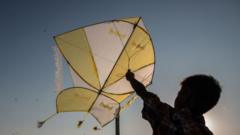In a vibrant paddy field just two kilometers from Jakarta's international airport, a colorful tapestry of kites dances in the sky, often interrupted by the ear-splitting roar of approaching planes. A group of children, including seven-year-old Atif, joyfully flies their kites with enthusiasm despite the risks involved. "In the past, I used to run away when officials came," he shares with a smile. "Now I’m braver—I accept it when they scold me."
Kite-flying in Indonesia, particularly during the summer school holidays, is not just a pastime; it’s an essential part of the culture. However, local authorities are sounding alarms over this beloved activity, citing safety concerns for aircraft that could be negatively impacted by kites blocking sensors or tangling in engines. According to AirNav Indonesia, a notable incident occurred earlier this month when 21 flights were disrupted over three days due to kites, resulting in some flights being redirected and others abandoning landings because of safety issues.
Putu Eka Cahyadi, the head of the Soekarno-Hatta International Airport Authority, warned that kites are "moving obstacles" for planes, posing "serious risk to flight safety." The stakes are high; a helicopter crash in Bali last July due to entangled kite strings and incidents involving kites found in aircraft engines underscore the urgency of the situation.
Despite these warnings, children persist in their kite-flying, drawn to the activity that connects them to their cultural heritage. Traditionally, kites, crafted from leaves, paper, or cloth, serve various purposes, from rituals to pest control during rice harvests. Asep Irawan, a kite expert, explained that the practice has been ingrained in Indonesian culture for generations, yet the safety risks are concerning, especially among children who may not grasp the potential dangers of their play.
Authorities have instituted strict measures, including potential imprisonment and heavy fines for those caught flying kites near airports, yet enforcement remains challenging. Tragedy can strike in urban areas as well, as seen last year when an eight-year-old boy was fatally injured while chasing a kite on a busy road, illustrating the broader risks associated with kites.
Young enthusiasts, like 17-year-old Rasha, share the struggle to find suitable places to fly their kites, with Jakarta losing significant green spaces over the past two decades. There are limited options for safe flying spots, leading to more children gathering in the paddy field, where kite-flying competitions have grown popular. Rasha, a two-time competition winner, recounts past encounters with officials: "The police came to our house and took my kites and burned them. My siblings told me to stop after that,” he admits, but his passion drew him back to the field.
Even amidst the inherent dangers and legal threats, the children continue to fly kites, embodying the spirit of a cherished cultural pastime against a backdrop of safety concerns. "It's pretty dangerous," confesses Rasha, "but once your kites have been taken away, you stop being afraid." As they navigate this tug of war between tradition and safety, the colorful kites will likely continue soaring in Indonesia's skies.




















